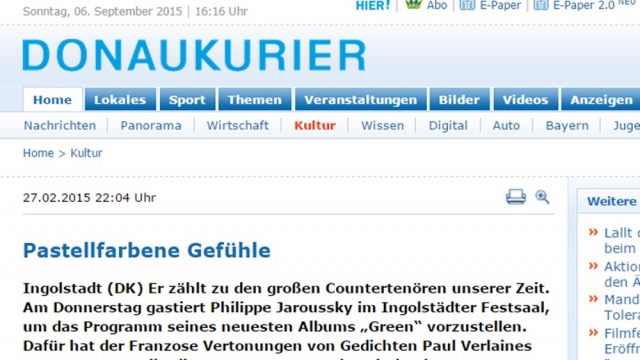2015-02-27, Donaukurier
Dann haben Sie ja noch einiges vor sich, oder?
Jaroussky: Natürlich werden die Alte und die Neue Musik für Countertenöre weiterhin das zentrale Repertoire sein. Aber ich bin davon überzeugt, dass heute Countertenöre darüber hinaus Weiteres erschließen müssen – auch ein Repertoire wie auf dem „Green“-Album. Für meine Stimme eignen sich übrigens auch die „Kindertotenlieder“ von Mahler, zwei oder drei habe ich bereits gesungen.
There’s a lot yet to be done then, isn’t it?
Jaroussky: Of course, early and new music will continue to be the core of the countertenor repertoire. I am convinced, however, that today, countertenors have to explore further – which includes a repertoire like the one on “Green.” By the way, the “Kindertotenlieder” by Mahler also suit my voice, two or three I have even sung already.
Source/Read more: Donaukurier (paid content)
The following is not a professional translation; no profit is being made, no infringement of copyright is intended.
Pastel-Coloured Feelings
Ingolstadt (DK) He is one of the great countertenors of our time. On Thursday, Philippe Jaroussky performs at the Ingolstädter Festsaal, introducing his latest album “Green.” For this, the Frenchman has compiled different settings of Verlaine’s poems that were created around 1900 – amongst others, by Gabriel Fauré or Claude Debussy. Jaroussky comes to Ingolstadt along with his pianist Jérôme Ducros, to capture the sound-sensual atmosphere of the French “Fin de Siècle.
Mr Jaroussky, you are a countertenor. So why do you sing settings to music of Verlaine’s poems, created around 1900?
Philippe Jaroussky: Because, on one hand, I want to show that it is perfectly possible for an opera singer to give recitals. On the other hand, I feel very attracted by the settings to music of Verlaine and French song. In opera – more so, in Baroque, which is obviously the center piece for us countertenors – you have to give shape to hysterical feelings sometimes. You kill, you are jealous, insidious. At some very dramatic moments, I reach my limits. Whereas in French song, I have to express more pastel-coloured feelings, a lot of melancholia, just to name one. It might sound strange as a countertenor, but I feel at home in this repertoire.Nevertheless, originally, the musical settings weren’t written for a countertenor voice. What is your reply to nagging purists?
Jaroussky: Mainly in France, there are more than a few. I tend to respond that primarily, these songs were written for voices that should express the poems – no more, no less. Why shouldn’t a countertenor be able to express this repertoire just as well? Basically, countertenor is a very modern voice type – because it was only rediscovered in the 20th century. Today, there are many young composers who are interested in this voice type.On the other hand, in the past, many parts for written for castrati and countertenors used to be sung by female voices. [translator’s note: I don’t know which parts for countertenors he is referring to here; I cannot think of any that were ever sung by women. Roles written for countertenor are, e. g., Oberon in Benjamin Britten’s “A Midsummer Night’s Dream” or Ganesha in Somtow Sucharitkul’s “Ayodhya”] Correspondingly, why shouldn’t countertenors be allowed to sing female parts?
Jaroussky: Absolutely right, and it is done already. Most of Verlaine’s poems are written from a man’s point of view. Frequently, it is Verlaine himself who is talking there. Therefore, it’s only logical if a high male voice is singing these songs. For me, the songs are somewhat introspective because they make me feel how French I really am. Maybe that’s comparable to a German who sings Schubert songs. It’s intrinsic; you realize completely intuitively what comprises these songs. When I made “Opium,” the first album of this kind, it was a huge success – particularly in Germany.What is it that makes the poems of Verlaine so musical?
Jaroussky: Sometimes, Verlaine expresses a whole world in a few verses. Verlaine prefers a concise form, and this shortness, in which many shades are applied within a very confined space, makes it prone for setting it to music. Also, sometimes one and the same words are repeated; they appear in a different context, in different colours, often with the emphasis shifted very subtly. Rhythmically, this produces some interesting results. But above all,Verlaine creates whole worlds in the most confined spaces, which I think is why many composers were tempted to set his poems to music.Because, when it comes down to it, you are an instrumentalist?
Yes, originally, I was a violinist and a pianist. I do sing a lot with orchestras and it is wonderful. However, when you sing with piano accompaniment, you have complete freedom. Everything is reduced to the essentials. The contact between two musicians is a lot more immediate, it’s possible to change some nuances very quickly – especially when you know each other very well. Jérome Ducros knows me very well; we both know each other very well.To what extent are the sounds of the “Fin de Siècle” yet to be rediscovered?
Jaroussky: Generally, this is true for many eras. There was a time when high male voices were forgotten. Yet I believe that, for instance, Gustav Mahler would probably have chosen a countertenor today for the the last movement of his Symphony No. 4, where he requires a “childlike, boyish expression.” And about Richard Wagner, we know that for the part of Klingsor, he was considering the last great castrato, Domenico Mustafà.There’s a lot yet to be done then, isn’t it?
Jaroussky: Of course, early and new music will continue to be the core of the countertenor repertoire. I am convinced, however, that today, countertenors have to explore further – which includes a repertoire like the one on “Green.” By the way, the “Kindertotenlieder” by Mahler also suit my voice, two or three I have even sung already. But we countertenors can sing Mozart as well as, in fact some of my colleagues are going already, or even Belcanto. A countertenor performing at Covent Garden in London would have been unimaginable some time ago. The technical level has risen to a degree that we can also sing dramatic parts. For myself, I think I will turn more to Johann Sebastian Bach and Georg Friedrich Händel, or Henry Purcell.Interview by Marco Frei


